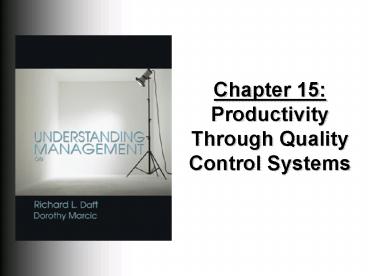Chapter 15: Productivity Through Quality Control Systems - PowerPoint PPT Presentation
1 / 24
Title:
Chapter 15: Productivity Through Quality Control Systems
Description:
Explain the four steps in the control process. ... Basic information for financial control ... Participation and teamwork are used to tackle significant problems ... – PowerPoint PPT presentation
Number of Views:98
Avg rating:3.0/5.0
Title: Chapter 15: Productivity Through Quality Control Systems
1
Chapter 15Productivity Through Quality Control
Systems
0
2
Learning Objectives
0
- Define organizational control and explain why it
is a key management function. - Describe differences in control focus, including
feedforward, concurrent, and feedback control. - Explain the four steps in the control process.
- Contrast the bureaucratic and decentralized
control approaches. - Describe the concept of total quality management
and major TQM techniques. - Explain the value of open-book management and the
balanced scorecard approaches to control in a
turbulent environment.
3
Managerial and Quality Control
0
- Control is a critical issue facing every manager
in every organization today - Quality control
- Office productivity
- Basic systems
- allocating financial resources,
- developing human resources,
- analyzing financial performance, and evaluating
overall productivity
4
Organizational Control
0
- The systematic process through which managers
regulate organizational activities to make them
consistent with expectations established in - Plans
- Targets
- Standards of Performance
5
Organizational Control
0
- Managers need to decide
- What information is essential
- How will they obtain that information
- How they can/should respond
6
Three Types of Control
0
- Feed forward
- Preliminary or preventive control
- Concurrent
- Assesses current work activities
- Rules and regulations
- Ensure that work activities produce the correct
results - Feedback
- Focuses on the organizations outputs also
called post-action or output control
7
Organizational Control Focus
0
Exhibit 15.1
8
Feedforward Control
0
- Preliminary or preventive control
- Identify and prevent deviations
- Forecasting trends and managing risk
9
Concurrent Control
0
- Monitors ongoing activities to ensure consistency
- Assesses
- Current work activities
- Relies on performance standards
- Includes rules and regulations
10
Feedback Control
0
- Focuses on outputs
- Post action or output control
- Establish Standard of Performance
- Measure Actual Performance
- Compare Performance to Standards
11
Feedback Control Model
0
Exhibit 15.2
12
Budgetary Control
0
- Most commonly used method of managerial control
- Expense budgets
- Revenue budgets
- Cash budgets
- Capital budgets
- Process of setting targets
- Top-down budgeting
- Bottom-up budgeting
- Monitor results and compare to budget
13
Responsibility Center
0
- Organizational unit under the supervision of a
single person who is responsible for its activity
14
Financial Statements
0
- Basic information for financial control
- Balance sheet- shows firms financial position
with respect to assets and liabilities at a
specific point in time - Income statement- summarizes the firms financial
performance for a given time interval
(profit-and-loss statement)
15
Control Philosophies
0
- Bureaucratic control
- rules
- policies
- hierarchy of authority
- reward systems
- written documentation
- Decentralized control
- cultural values
- traditions
- shared beliefs
- trust
16
Lean Manufacturing
- Cut Waste
- Improve Quality
- Problem Solving
- Highly Trained Employees
- Employee Empowerment
- Think Lean
- Stop Production Lines
17
Measuring Productivity
- Organizations output of products and services
divided by its inputs - Total Factory Productivity
- Partial Productivity
18
Total Quality Management (TQM)
0
- Organizationwide commitment to infusing quality
into every activity through continuous
improvement - Quality circles
- Benchmarking
- Six Sigma
- Reduced cycle time
- Continuous improvement
19
TQM Success Factors
0
- Tasks make high skill demands on employees
- TQM serves to enrich jobs and motivate employees
- Problem-solving skills are improved for all
employees - Participation and teamwork are used to tackle
significant problems - Continuous improvement is a way of life
20
Trends in Quality Control
0
- International Quality Standards
- Economic Value-Added (EVA)
21
Control Systems for Turbulent Times
0
- Open-Book Management
- sharing financial information and results with
all employees - Balanced scorecard
- comprehensive management control system
22
The Balanced Scorecard
0
Exhibit 15.9
23
New Workplace Concerns
- Corporate Governance
- Undercontrol
- Overcontrol
24
A New ApproachBalance Scorecard
Financial Performance
Internal Business Processes
Customer Service
Exhibit 15.10
Learning and Growth































